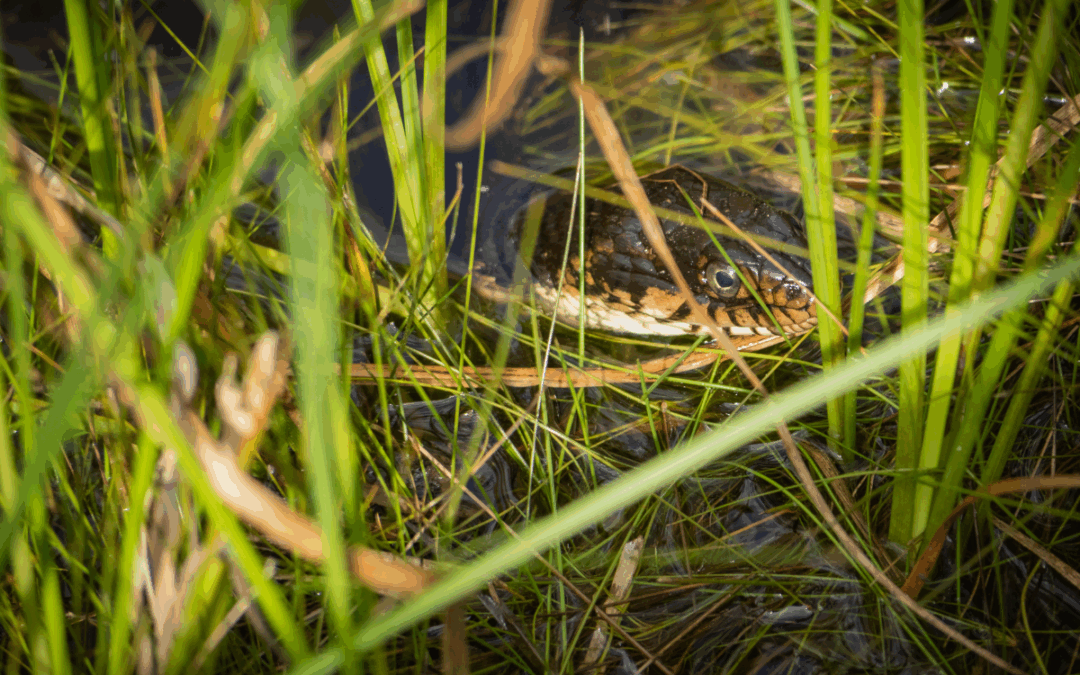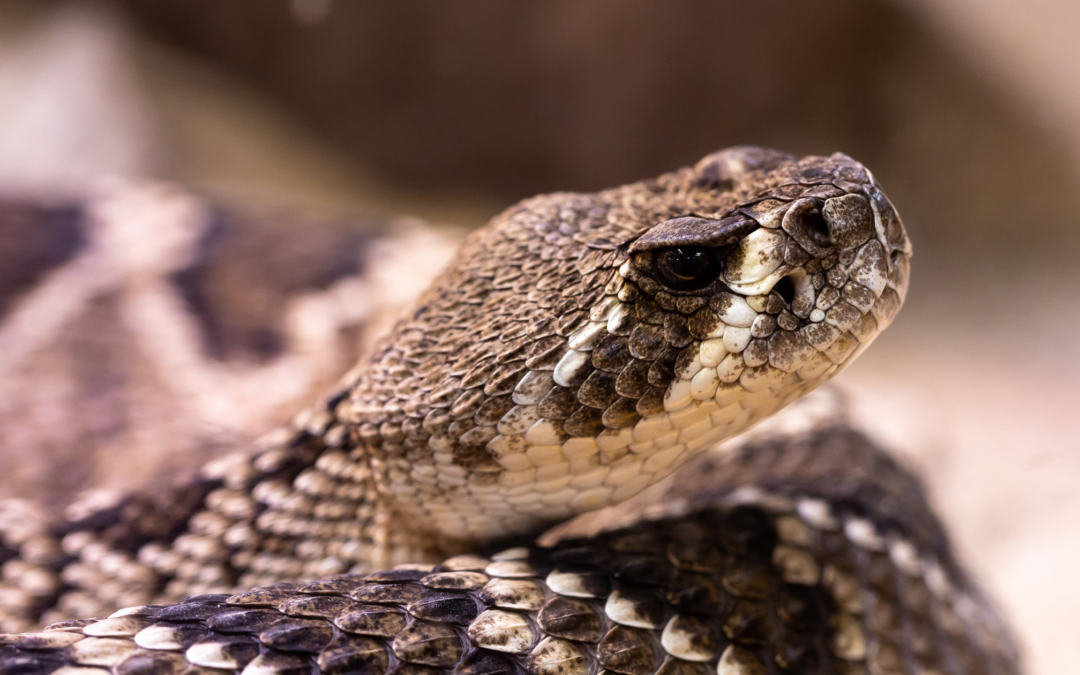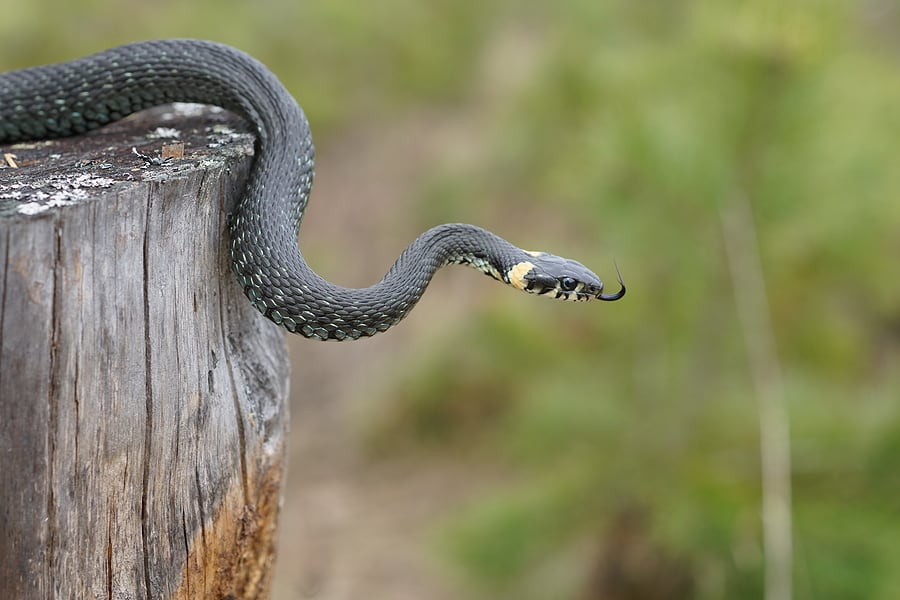READY TO GET STARTED?
REQUEST A FREE ESTIMATE
Fill out the form below or call (888) 466-7849 for a free, no-obligation estimate.

Florida’s warm climate and diverse ecosystems create habitats for over 46 snake species, making encounters a normal part of life. While most are harmless, six venomous species live here, making it important to know which ones pose risks and how to identify them. Education, prevention, and knowing how to respond are key. By understanding snake behavior, recognizing warning signs, and using proven prevention strategies, you can protect your family from Florida snakes while respecting these important members of Florida’s ecosystem.
Florida’s largest venomous snake can grow up to eight feet. Recognizable by diamond-shaped patterns and a rattling tail, they inhabit pine flatwoods, scrub areas, and coastal regions. Their venom is powerful, but these snakes usually avoid people unless threatened.
Often found in swamps, marshes, and lakeshores, cottonmouths have dark bodies and a white mouth interior. Unlike many snakes, they may hold their ground when approached. Their venom can cause significant tissue damage.
Coral snakes have bright red, yellow, and black bands. Remember: red touches yellow, kills a fellow to distinguish them from non-venomous lookalikes. Secretive by nature, they prefer sandy soils and wooded areas. Their venom affects the nervous system.
Found in northern Florida, copperheads have copper-colored bodies with hourglass-shaped crossbands. While their venom is rarely fatal with treatment, it can cause pain and swelling.
Timber rattlesnakes live in northern forests, while pygmies are found statewide. Both have rattles, though pygmy rattles are faint. Venom can cause serious complications without treatment.
Wetlands, pine flatwoods, scrub areas, and hardwood hammocks provide shelter for many species. Cottonmouths thrive near water, while coral snakes prefer sandy or wooded areas.
Yards with ponds, irrigation systems, or dense vegetation can attract snakes and their prey. Brush piles, woodpiles, and overgrown plants provide ideal hiding spots. Garages, sheds, and crawl spaces also offer shelter.
Venomous snakes may have triangular heads, vertical pupils, and heat-sensing pits, though these traits can be misleading. Instead, learn the distinct patterns and colors of dangerous species.
Rattlesnakes shake their tails to warn intruders, cottonmouths show their white mouths, and most snakes retreat if given the chance. Striking is typically a last resort.
Keep grass trimmed, remove brush piles, and maintain a clear perimeter around the home. This reduces shelter for both snakes and the small animals they hunt.
Seal gaps under doors, cracks in foundations, and utility entry points. Use hardware cloth barriers under porches or decks. Fix leaks and eliminate standing water to discourage both snakes and their prey.
Stay calm and slowly back away. Never try to catch or kill a venomous species. Give it space to escape.
Call 911 or go to the nearest emergency room immediately. Never attempt to capture the snake, as this is unnecessary and could result in another bite. Remove jewelry and tight clothing from the affected area, and keep the person as still as possible until help arrives.
Florida’s snakes play a vital role in controlling pests and maintaining ecological balance. Learning how to identify species, modify your property, and respond appropriately will help you coexist with these reptiles. If you’re unsure whether a snake is venomous or how to handle an encounter, a trained snake removal expert can provide proper identification and humane removal. Contact us today for a free snake removal quote!

South Florida’s warm climate and lush landscapes make it the perfect habitat for a wide range of wildlife—including snakes. While most snakes you may encounter are harmless, a few dangerous snakes, such as water moccasins or coral snakes, can pose serious threats to people and pets. So what should you do if you come across a snake in your yard? And who should you call to get rid of it? Let’s explore the best steps to take when dealing with unwanted slithering visitors—and how professional snake removal can keep your home safe.
First things first: don’t panic. Whether it’s venomous or not, any snake that feels threatened can become defensive and strike. If you spot a snake:
Stay calm and keep your distance
Do not attempt to touch, trap, or kill the snake
Keep children and pets indoors
Note the snake’s size, color, and behavior (from a safe distance)
Trying to handle a snake yourself is dangerous and can result in injury. Many homeowners aren’t equipped to determine whether a snake is venomous or not—so it’s best to leave identification and removal to the experts.
If you need snake removal near you in South Florida, call a licensed snake pest control company that specializes in wildlife removal. Professional snake removal services will:
Safely capture and relocate the snake
Identify the species (especially important for venomous snake sightings)
Inspect your property for potential entry points
Recommend preventative measures for long-term snake control
Snakes often enter yards in search of food, water, or shelter. If your property has overgrown grass, open sheds, debris piles, or rodent activity, it could be attracting snakes without you even realizing it.
Attempting to remove a snake on your own is not only risky—it could also be illegal in some cases. Professional snake removal services use humane, legal methods to handle snakes safely and protect native species. They’ll also help you seal up entry points and provide tips to prevent future encounters with these slithery guests.
If you’ve spotted a snake around your home, don’t take any chances. Our trained technicians offer fast, safe, and effective snake removal services throughout South Florida. Whether you’re dealing with a venomous snake or just want peace of mind, we’re here to help with expert snake control solutions.
Contact us today for professional snake removal near you! Let us help you take back your yard—safely and quickly.

If you live in Georgia, you know that the state’s warm climate and diverse ecosystems are home to a variety of wildlife, including snakes. Encountering a snake in your yard or home can be unsettling, but knowing how to handle the situation safely is crucial. This guide will provide you with essential information on what to do if you come across a snake, how to identify venomous and nonvenomous snakes in Georgia, how to practice safe snake removal, and prevent snakes from entering your property.
Georgia is home to both venomous and nonvenomous snakes. Here are key identifiers:
If you’re dealing with a snake problem and need professional help, search for “snake removal near me” to find a trusted wildlife control company in your area. These experts can safely and humanely remove snakes from your property and provide advice on preventing future encounters.
Encountering a snake can be a frightening experience, but with the right knowledge and precautions, you can handle the situation safely. Remember to stay calm, keep your distance, and contact professionals for help with snake removal. By taking steps to prevent snakes from entering your property, you can reduce the likelihood of future encounters. Stay vigilant, and don’t hesitate to reach out to wildlife control companies for expert assistance in managing your snake problem.

Living in the beautiful state of Georgia comes with its fair share of wildlife encounters, and one of the most feared encounters for many homeowners is stumbling upon a venomous snake. With over 40 species of snakes slithering through the Georgia landscape, it’s essential to know how to distinguish between harmless serpents and those that pose a threat. In this guide, we’ll explore common venomous snakes in Georgia, their identifying features, where they can be found, associated risks, and what to do if you encounter one. Additionally, we’ll provide tips on how to deter venomous snakes from entering your yard, ensuring a safer environment for you and your family.
If you come across a venomous snake on your property or while out in nature, it’s crucial to remain calm and follow these steps:
Prevention is key when it comes to keeping venomous snakes away from your property. Here are some tips to deter them:
By familiarizing yourself with the common venomous snakes in Georgia and taking proactive measures to deter them from your property, you can minimize the risk of encountering these potentially dangerous reptiles. Remember, when it comes to venomous snakes, caution and prevention are your best defenses.
If you encounter a venomous snake on your property and need assistance with snake relocation or wildlife control, don’t hesitate to contact a reputable wildlife control company in your area. Stay safe and informed, and enjoy the beauty of Georgia’s wildlife responsibly.

Most snakes you encounter are harmless, with only a few species of venomous snakes in Georgia. In fact, most snake bites occur when the snake is accidentally handled or touched when walking or climbing. Although most snakes aren’t aggressive and will flee rather than attack, it is still important to be safe when spending time outdoors. Here are some snake safety tips you can use this snake season.
Keeping yourself and your family safe from snakes while spending time outdoors is very important. If you have a problem with snakes or other wildlife, contact your local pest control company for assistance.